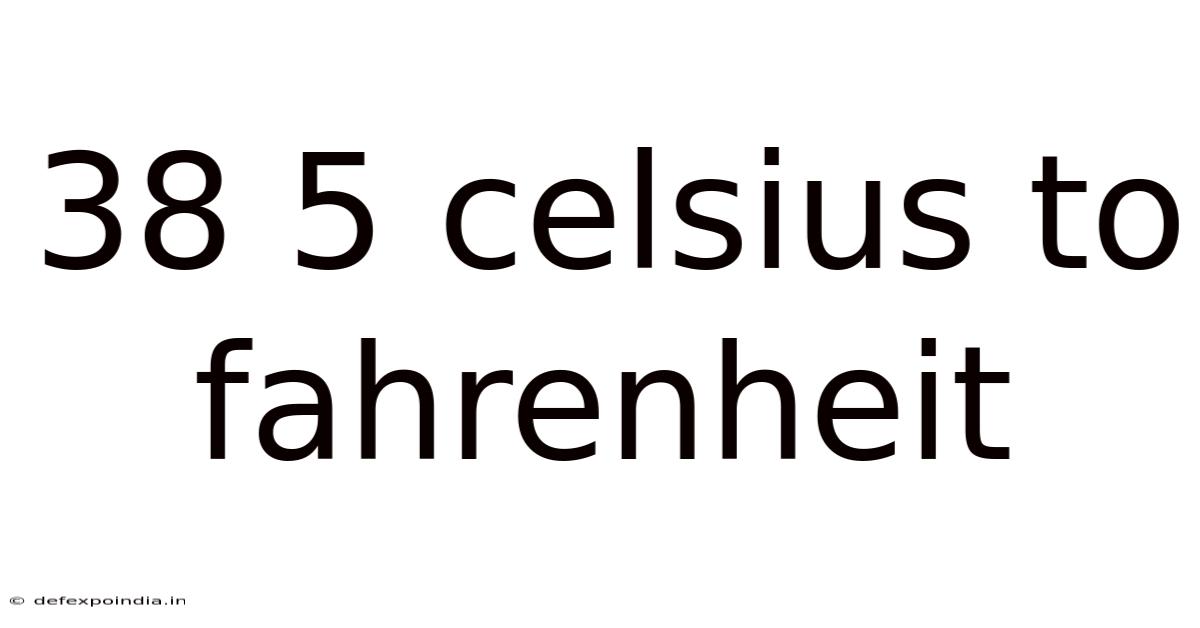38 5 Celsius To Fahrenheit
defexpoindia
Sep 21, 2025 · 4 min read

Table of Contents
Converting 38.5 Celsius to Fahrenheit: A Comprehensive Guide
Have you ever wondered how to convert Celsius to Fahrenheit? Understanding temperature conversions is crucial in various fields, from cooking and everyday life to scientific research and meteorology. This comprehensive guide will walk you through converting 38.5 degrees Celsius to Fahrenheit, explaining the process, the science behind it, and answering frequently asked questions. We'll also explore practical applications of this conversion and delve into the history of these temperature scales. By the end, you'll not only know the answer but also understand the underlying principles.
Understanding Celsius and Fahrenheit
Before we begin the conversion, let's briefly review the two scales:
-
Celsius (°C): Also known as the centigrade scale, Celsius is a metric temperature scale where 0°C is the freezing point of water and 100°C is its boiling point at standard atmospheric pressure. It's widely used globally, particularly in scientific contexts.
-
Fahrenheit (°F): This scale is primarily used in the United States. Water freezes at 32°F and boils at 212°F at standard atmospheric pressure.
The Conversion Formula: From Celsius to Fahrenheit
The formula to convert Celsius to Fahrenheit is:
°F = (°C × 9/5) + 32
Where:
- °F represents degrees Fahrenheit
- °C represents degrees Celsius
Step-by-Step Conversion of 38.5°C to °F
Now, let's apply this formula to convert 38.5°C to Fahrenheit:
-
Multiply by 9/5: 38.5 °C × 9/5 = 69.3 °F
-
Add 32: 69.3 °F + 32 = 101.3 °F
Therefore, 38.5 degrees Celsius is equal to 101.3 degrees Fahrenheit.
A Deeper Dive into the Science Behind the Conversion
The conversion formula isn't arbitrary; it's rooted in the relationship between the two scales. The factor 9/5 (or 1.8) accounts for the different sizes of the degrees in each scale. The Fahrenheit scale has smaller degree increments than the Celsius scale. Adding 32 adjusts for the difference in the zero points of the two scales. The freezing point of water (0°C) is set at 32°F, creating an offset.
This difference stems from the historical development of the scales. Anders Celsius, a Swedish astronomer, developed the Celsius scale in the 18th century, basing it on the freezing and boiling points of water. Gabriel Fahrenheit, a German physicist, developed his scale earlier, using a different reference point – a mixture of ice, water, and ammonium chloride.
Practical Applications of Celsius to Fahrenheit Conversion
Understanding Celsius to Fahrenheit conversion is essential in many situations:
- Cooking and Baking: Many recipes use either Celsius or Fahrenheit, so conversion is necessary for accurate results.
- Medicine: Body temperature is often measured in both Celsius and Fahrenheit. Knowing the conversion is important for understanding medical readings.
- Weather Forecasting: Weather reports often provide temperatures in both scales, depending on the region and target audience.
- Engineering and Science: Accurate temperature conversions are critical in various scientific and engineering applications.
- International Travel: Travelers need to understand temperature conversions to appropriately pack for their destination, especially if the country predominantly uses a different scale.
Beyond the Formula: Using Online Converters and Apps
While understanding the formula is crucial for a deeper comprehension, numerous online converters and mobile apps can perform this calculation instantly. These tools are convenient for quick conversions, especially when dealing with multiple temperatures. However, it's recommended to understand the underlying principles to fully grasp the meaning of the conversion.
Frequently Asked Questions (FAQ)
Q1: Why is the conversion formula not simply a ratio?
A1: The conversion isn't simply a ratio because the zero points of the two scales are different. The formula accounts for both the difference in degree sizes and the offset in zero points.
Q2: Are there other temperature scales besides Celsius and Fahrenheit?
A2: Yes, the Kelvin scale is another widely used temperature scale, especially in scientific contexts. It's an absolute temperature scale where 0 Kelvin (0 K) represents absolute zero, the theoretical lowest possible temperature.
Q3: How do I convert Fahrenheit to Celsius?
A3: The formula to convert Fahrenheit to Celsius is: °C = (°F - 32) × 5/9
Q4: What is the significance of the boiling and freezing points of water in these scales?
A4: The boiling and freezing points of water serve as fixed reference points for both scales, providing a consistent and easily reproducible benchmark for temperature measurement. These points allow for standardization across measurements.
Q5: Are there any potential errors in converting temperatures?
A5: Errors can arise from rounding off numbers during the conversion process or from using inaccurate input values. It's always best practice to use as many decimal places as possible throughout the calculation to minimize error. Using online converters can also help to double-check your calculations.
Conclusion: Mastering Temperature Conversions
Converting 38.5 degrees Celsius to Fahrenheit, as demonstrated, involves applying a simple yet fundamental formula. Beyond the calculation itself, understanding the underlying science, historical context, and practical applications enhances our understanding of temperature measurement and its significance in various fields. While convenient tools are available for quick conversions, grasping the principles behind the formula empowers you to make these conversions confidently and accurately, contributing to a more robust understanding of the physical world. Remember, accurate temperature measurement is essential for a wide range of activities, highlighting the importance of mastering this fundamental conversion.
Latest Posts
Latest Posts
-
How Many Hours In A Year
Sep 21, 2025
-
How Far Is 550 Meters
Sep 21, 2025
-
3 3 As A Decimal
Sep 21, 2025
-
7 1 2 As A Decimal
Sep 21, 2025
-
7 Degree Fahrenheit To Celsius
Sep 21, 2025
Related Post
Thank you for visiting our website which covers about 38 5 Celsius To Fahrenheit . We hope the information provided has been useful to you. Feel free to contact us if you have any questions or need further assistance. See you next time and don't miss to bookmark.